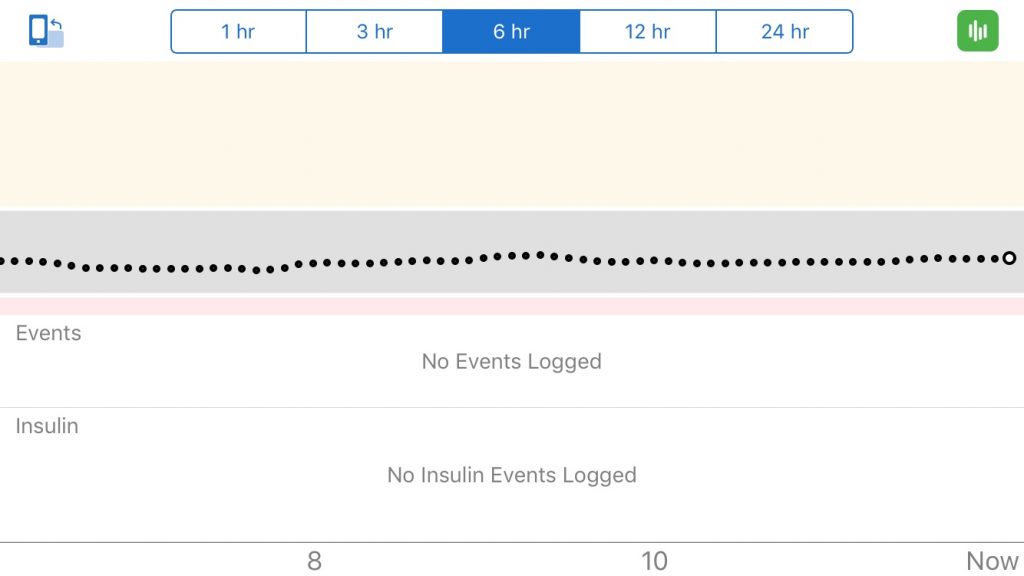
I had the same breakfast today as yesterday, but yesterday it kicked me to over 170, and today it didn’t impact my levels noticeably. Go figure.

I had the same breakfast today as yesterday, but yesterday it kicked me to over 170, and today it didn’t impact my levels noticeably. Go figure.
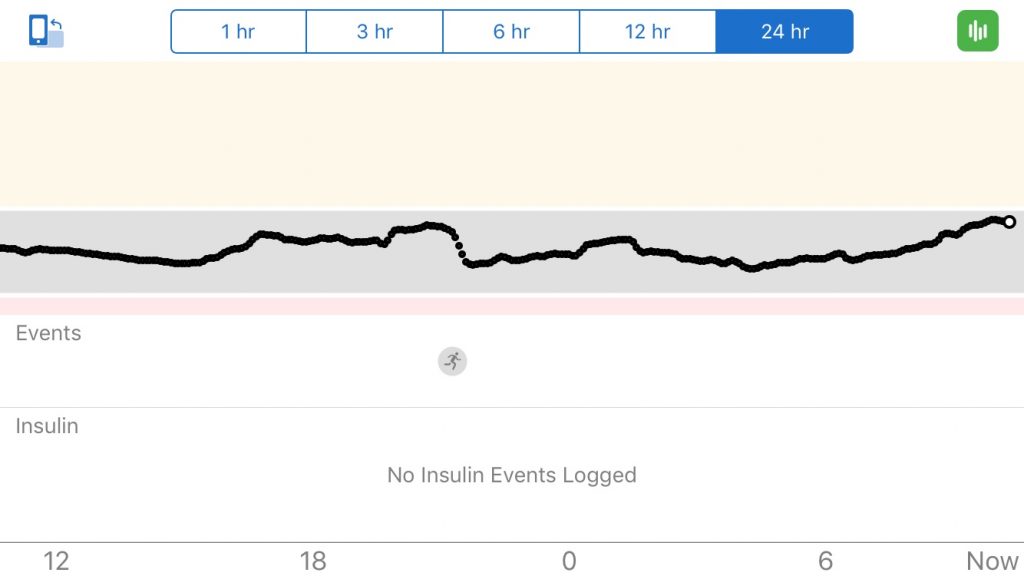
I added nonfat yogurt to nut cereal today, and got faster/higher BG increase than on other days w just almond milk. See BG rising to 170 after breakfast. Also, just now taking fiber, a couple hours after breakfast. Might fiber have buffered the rapid climb?
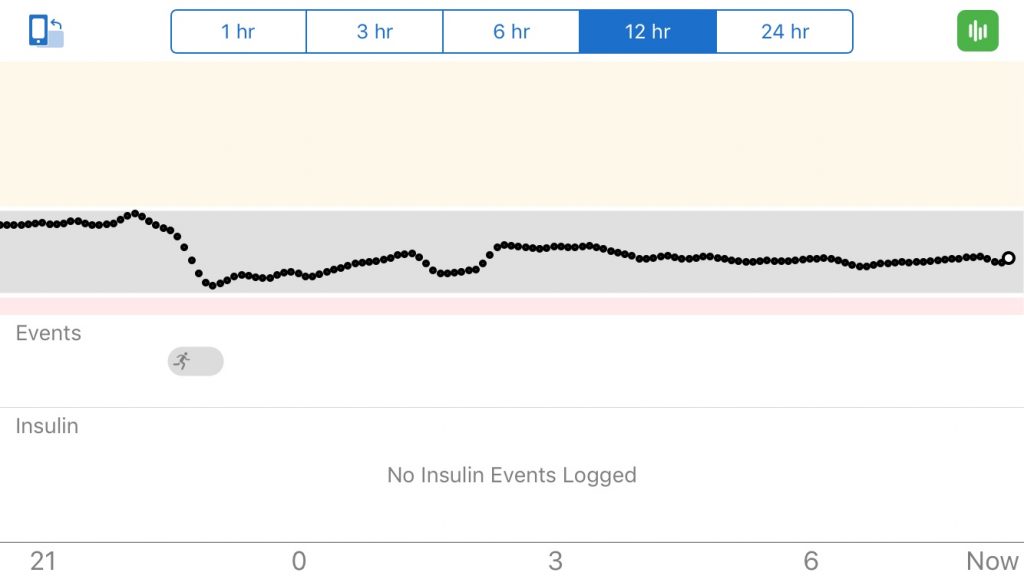
Last night’s exercise brought my BG back down, and then it started climbing back up, as it does. At 1:30 am I see the signature drop and recovery that I’ve started seeing overnight lately. I wonder what causes that.
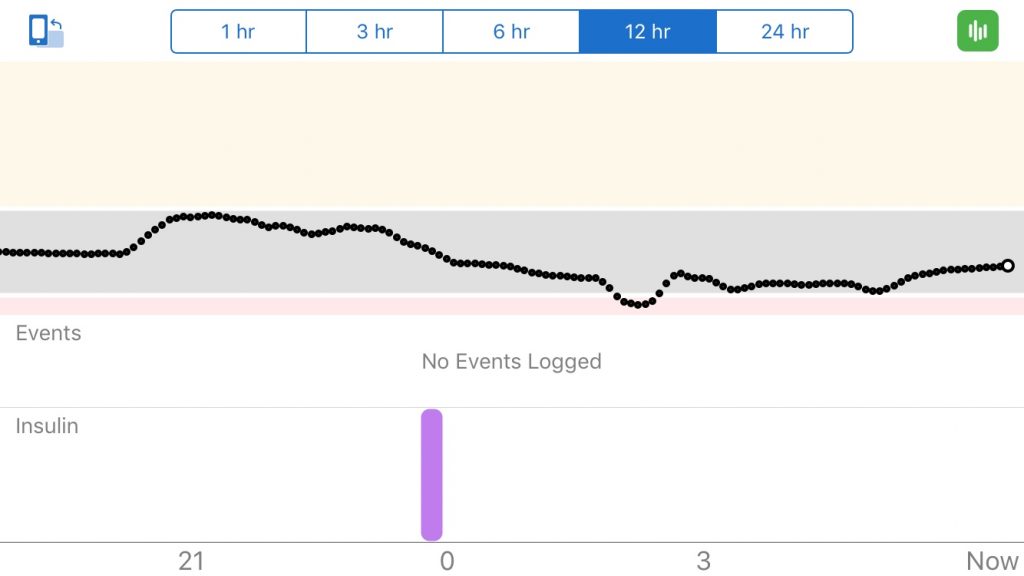
Dinner last night took me to ~180, but then began to drop. Because I couldn’t exercise before bed, I bolused 2 units of fast acting insulin when I was back down to 137. It dropped me below 70 – a dramatic amount for only 2 units. Then I dipped and rebounded. I stayed at 70 until waking. I’m far more sensitive than normal.
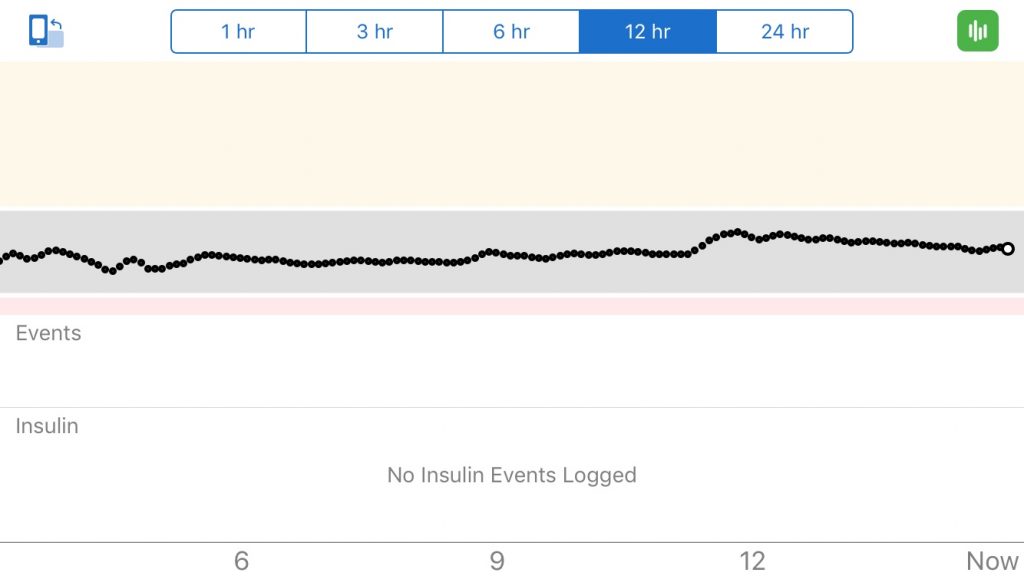
The bump at 11:00 am is from breakfast – bowl of nuts. That’s maybe a higher bump than other days when my BG levels were even lower over all, but the level then drops on its own back to a normal level. That’s encouraging.
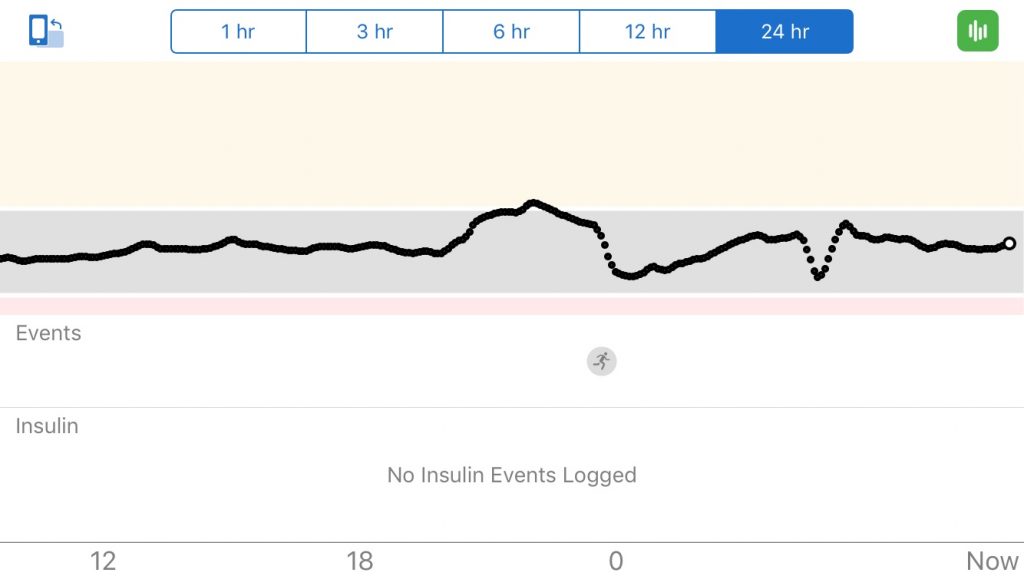
BG control: look at the BG levels overnight. My overnight regulation is not as good as in prior days. I may have jinxed myself by suggesting that I was using less insulin because this profile looks like I could use some Humulin overnight. Most curious is the virtual crash at about 4 am followed by a rebound and over-compensation. I don’t know what could have accounted for that. I didn’t have any insulin on board. I was having vivid dreams. It can’t imagine that would have affected anything, but who knows. I’ve never seen a spontaneous drop like that before. I was asked why I thought I had needed to use insulin on Friday morning after a month without. I thought two possible causes: (1) my levels have been gradually climbing since starting a trial with fiber, and (2) I had more carbs that morning while making breakfast and lunches for the kids than normal, so I assumed I’d need it. The first spike on this screenshot is from dinner. I started dinner around 140 BG.
I’ve been doing a lousy job of getting enough sleep this week. So, as I’d expect, my levels are more insulin-dependent than they might be if I were well-rested. The profile from yesterday shows that I needed to match bolus insulin to carb intake to keep myself in my target range.
I did walk on the treadmill as I computed in the late morning. That kept my blood sugar level.
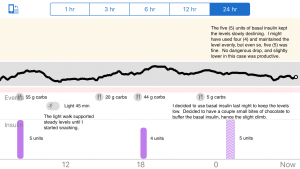
As I prepared for bed (lights out at 1 am…), I took stock of my overall condition and decided that basal insulin overnight would be a good idea to keep my levels even. I injected five (5) units. Seeing how the levels declined overnight, I might have been able to get away with just four (4) units and maintain the level even. But because the levels didn’t drop too far, five (5) was probably the right call.
Yesterday I was under deadline pressure and didn’t exercise much. I took the easy path and bolused around each meal to keep the peaks low. I did try adding a little burst of exercise along with the insulin to see how that continues to work. So far, so good. It worked at lunch and dinner. For lunch, I walked on the treadmill for 30 minutes after eating, and then I used the elliptical for 20 minutes in addition to insulin to bring my levels down quickly before going to bed.
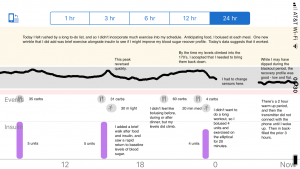
A novel wrinkle was that I had to change CGM sensors shortly after finishing my 20 minutes on the elliptical last night before going to sleep. I inserted another, but there is a gap in the data of about four hours. It is possible that my levels dropped low as I slept because of having insulin on board and exercising, but I don’t know and I didn’t wake up in sweats. At least the long tail looked good. When the data returned, I was within target range and even for the duration of the night. This is strategy may hold promise. There is more to learn about this.
Yesterday’s data tells me two interesting things: 1) My new insight into bolusing AND exercising carefully to rapidly drop my blood sugar levels is paying dividends, and 2) Not going to be early may be hurting my blood sugar control. Let’s start with this second point.
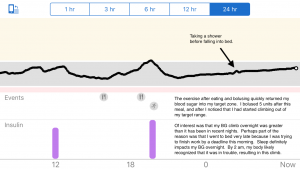
I didn’t hit the pillow before 2 am last night. You can see the blip in the climbing level that indicates where I took my shower just before bed. As my body detected that I was not going to hit the hay, and it drew on stress hormones to keep me awake, my blood sugar levels started to rise. That trajectory continued throughout the night at a remarkably even rate.
My mother always campaigned that the hours of sleep before midnight were worth twice the hours after midnight. My wife recently heard from a friend that the restorative energy of the body is given to repair if the body is asleep by 10:30 pm or so (in adults). If the person is not asleep, then that energy that would have gone to repair is redirected toward staying awake. The upshot is that the body misses that day’s repair. I can only imagine how much deferred maintenance I’ve accumulated over the years. It may be a large contributor to my having become diabetic in the first place. I don’t have any proof of that, but I’m suspicious that it might have played a part.
The first point I found interesting was to see how a little exercise (as in five (5) minutes) with insulin could bring my levels down much faster than just insulin alone.
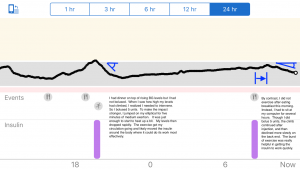
You can see on the left how quickly my levels dropped with only five (5) minutes of elliptical. It was just enough to feel myself start to get a little warm. The next morning, I was not physically active at all. The result was that there was a latency in the effectiveness of the insulin of about an hour, and the rate at which it dropped my levels was much lower. I’ve inserted relative angle sketches to emphasize the contrast.
There is also likely a difference between gradual walking and an intense burst of exercise. I’ll have to do some experiments between those two scenarios to see what conclusions I might draw.
Saturday and Sunday were good blood sugar days. I’ll surmise that getting more sleep on the weekend than I do during the week may have had a hand in what I witnessed in my CGM data.
On Saturday night we went out to an indulgent dinner at a Chinese restaurant. I didn’t eat any rice, but the starch in many of the sauces, the dumplings, and the green onion pancakes are all hard to resist. So I bolused six (6) units as dinner began and watched how high I climbed. To my surprise, the six (6) units held a blood sugar spike at bay. I hovered in the high 160’s/low 170’s after dinner. That wasn’t bad given my indulgence.
What I found surprising, however, was that at about four and half hours after initially bolusing, my sugar levels dropped down into target range without any further insulin or exercise. My overnight levels stayed even, and even dropped Sunday morning as I got up and started moving around.
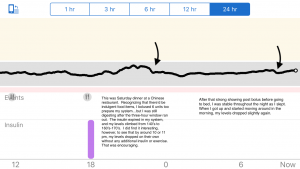
I found it additionally interesting that this continued into Sunday night when we had a family dinner at the in-laws. There was food, but there was also homemade desserts. I’m not sure why I didn’t bolus in preparation for that, but my levels stayed remarkably even after dinner given that my belly was full. Detecting before going to bed that I still had much more digesting to do, I decided to bolus a catch up dose that would bring my levels into target range, and add basal insulin as well to keep those levels even throughout the night.
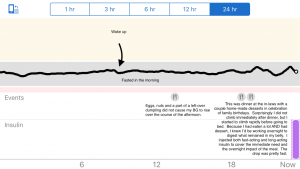
What I don’t understand is how my levels rose then fell of their own accord before injecting insulin at bed time. Could sleep have been the only factor.
If I could just get my act together and put myself to be earlier each night, who knows what I’d find…?